Analysis of Seismic Methane Anomalies at the Multi-Spatial and Temporal Scales
Abstract
:1. Introduction
2. Study Area
3. Data and Methods
3.1. Data
3.2. Methods
4. Analyses and Results
5. Discussion
6. Conclusions
Author Contributions
Funding
Data Availability Statement
Acknowledgments
Conflicts of Interest
References
- Du, L. Five Gas-Spheres and hydrogen, hydrocarbon resources in the earth-with a discussion on geodynamics of gas. Uranium Geol. 1993, 5, 257–265. [Google Scholar]
- Zhang, H.; He, T.; Zhao, Y.; Qian, Y. The state of fluids deep inside the earth and its significance in the physics of earthquake sources. Physics 2009, 38, 238–247. [Google Scholar]
- Zhu, H.; Wang, C. Degassing of the earth and its effects on environment of mankind. J. Catastrophology 1990, 4, 84–88. [Google Scholar]
- Irwin, W.P.; Barnes, I. Tectonic relations of carbon dioxide discharges and earthqukes. J. Geoghys. Res. 1980, 85, 3115–3121. [Google Scholar] [CrossRef]
- King, C.; Zhang, W.; Zhang, Z. Earthquke-induced Groundwater and Gas changes. Pure Appl. Geophys. 2006, 163, 633–645. [Google Scholar] [CrossRef]
- Voltattorini, N.; Quattrocchi, F.; Gasparini, A.; Sciarra, A. Soil gas degassing during the 2009 L’Aquila earthquake: Study of the seismotectonic and fluid geochemistry relation. Ital. J. Geosci. 2012, 131, 440–447. [Google Scholar] [CrossRef]
- Cui, J.; Shen, X.H.; Zhang, J.F.; Ma, W.Y.; Chu, W. Analysis of spatiotemporal variations in middle-tropospheric to upper-tropospheric methane during the Wenchuan Ms8.0 earthquake by three indices. Nat. Hazards Earth Syst. Sci. 2019, 19, 2841–2854. [Google Scholar] [CrossRef]
- Salazar, J.M.L.; Pérez, N.M.; Hernández, P.A.; Soriano, T.; Barahona, F.; Olmos, R.; Cartagena, R.; López, D.L.; Lima, R.N.; Melián, G.; et al. Precursory diffuse carbon dioxide degassing signature related to a 5.1 magnitude earthquake in EI Salvado, Central America. Earth Planet. Sci. Lett. 2002, 205, 81–89. [Google Scholar]
- Zhou, X.; Du, J.; Chen, Z.; Cheng, J.; Tang, Y.; Yang, L.; Xie, C.; Cui, Y.; Liu, L.; Yang, P.; et al. Geochemistry of soil gas in the seismic fault zone produced by the Wenchuan Ms 8.0 earthquake, southwestern China. Geochem. Trans. 2010, 11, 5. [Google Scholar] [CrossRef]
- Wu, L.X.; Liu, S.J.; Wu, Y.H. Infrared Remote Sensing for Rock Catastrophe Due to Overloaded; China Science Publishing & Media Ltd.: Beijing, China, 2006; pp. 240–244. [Google Scholar]
- Zhao, H. Preliminary analysis of the phenomenon of temperature increase in the epicentre area prior to the earthquake in the east Yunnan region. North China Earthq. Sci. 1984, 2, 53–58. [Google Scholar]
- Mil’kis, M.R. Meteorological precursors of earthquakes. Izv. Earth Phys. 1986, 22, 195–204. [Google Scholar]
- Jing, F.; Singh, R.P. Satellite Observed Multi-Parameter Variations Associated with the 2020 Yutian Earthquake, China. In Proceedings of the IEEE International Geoscience and Remote Sensing Symposium IGARSS, Brussels, Belgium, 11–16 July 2021. [Google Scholar]
- Xu, X.; Qiang, Z.; Lin, C. Anomalous ground warming before the 1976 Tangshan earthquake. Chin. Sci. Bull. 1992, 18, 1684–1687. [Google Scholar]
- Xu, X.; Xu, X.M.; Wang, Y. Satellite infrared anomaly before Nantou Ms = 7.6 Earthquake in Taiwan, China. Acta Seismol. Sin. 2000, 13, 710–713. [Google Scholar] [CrossRef]
- Jing, F.; Singh, R.P. Changes in tropospheric ozone associated with strong earthquakes and possible mechanism. IEEE J. Sel. Top. Appl. Earth Observ. Remote Sens. 2021, 14, 5300–5310. [Google Scholar] [CrossRef]
- Guo, G. Atmosphere Thermal Anomaly Before Zhangbei Earthquake in 1998. Technol. Rev. 2010, 28, 98–100. [Google Scholar]
- Tronin, A. Remote sensing and earthquakes: A review. Phys. Chem. Earth Part A/B/C 2006, 31, 138–142. [Google Scholar] [CrossRef]
- Toutain, J.P.; Baubron, J.C. Gas geochemistry and seismotec-tonics: A review. Tectonophysics 1999, 304, 1–27. [Google Scholar] [CrossRef]
- Wang, J.; Zhang, X.; Pan, L.; Zeng, Z. Anomalies of temperature increase and methane release before Lushan earthquake (Ms7.0). Earth Sci. Front. 2013, 20, 29–35. [Google Scholar]
- Cui, Y.J.; Du, J.G.; Chen, Y.; Liu, L.; Liu, H.; Yi, L.; Sun, F.X. Increasing of CO and CH4 Gas Emission at Longmenshan Fault Zone before and after Wenchuan Ms8.0 Earthquake. J. Seismol. 2016, 39, 239–245+175. [Google Scholar]
- Cui, Y.J.; Du, J.G.; Li, Y.; Guo, Q.N. Detecting anomalies of atmospheric total column CH4 and CO Related to the 2008 Wenchuan Ms8. 0 and 2013 Lushan Ms7. 0 earthquakes. Bull. Mineral. Petrol. Geochem. 2016, 35, 1022–1027. [Google Scholar]
- Li, X.Y.; Cui, Y.J.; Ma, H.Q.; Wei, D.J.; Wu, K.T. Anomalies on the changes of CH4 and CO related to the 15 April 2015 Alashan Zuoqi Ms5.8 earthquake in the Inner Mongolia. Earthquake 2019, 39, 54–62. [Google Scholar]
- Jiang, L.; Cui, Y.J.; Du, J.G.; Ding, Z.H.; Liu, Y.M.; Liu, Y.N. Satellite hyperspectral remote sensing geochemical anomalies associated with three strong earthquakes around the Qinghai-Tibetan Plateau. Earthquake 2021, 41, 129–144. [Google Scholar]
- Qiang, Z.J.; Xu, X.D.; Dian, C.G. Thermal infrared anomaly precursor of impending earthquakes. Chin. Sci. Bull. 1991, 36, 319–323. [Google Scholar] [CrossRef]
- Qiang, Z.J.; Xu, X.D.; Dian, C.G. Satellite thermal infrared anomalous temperature increase and impending earthquake precursor. Chin. Sci. Bull. 1992, 37, 1643–1646. [Google Scholar]
- Ye, M.Q.; Wu, Q.Y.; Yang, Z.D. Example of research on relation between satellite thermal infrared anomaly and strong earthquake. Chin. Sci. Bull. 1995, 40, 576–579. [Google Scholar]
- Saraf, A.K.; Choudhury, S. NOAA-AVHRR detects thermal anomaly associated with the 26 January 2001 Bhuj earthquake, Gujarat, India. Int. J. Remote Sens. 2005, 26, 1065–1073. [Google Scholar] [CrossRef]
- Panda, S.K.; Choudhury, S.; Saraf, A.K.; Das, J.D. MODIS land surface temperature data detects thermal anomaly preceding 8 October 2005 Kashmir earthquake. Int. J. Remote Sens. 2006, 28, 4587–4596. [Google Scholar] [CrossRef]
- Chen, M.H.; Deng, Z.H.; Ma, X.J.; Tao, J.L.; Wang, Y. Relation Analysis Method in Study on Satellite Infrared Anomalies Prior to Earthquake. Seismol. Geol. 2007, 29, 863–872. [Google Scholar]
- Chen, S.Y. A Study on the Quantitative Thermal Infrared Remote Sensing Method for Extracting Information of Current Tectonic Activity. Ph.D. Thesis, Institude of Geology, China Earthquake Administration, Beijing, China, 2006. [Google Scholar]
- Chen, S.Y.; Liu, P.X.; Liu, L.Q.; Ma, J.; Chen, G.Q. Wavelet analysis of thermal infrared radiation of land surface and its implication in the study of current tectonic activitis. Chin. J. Geophys. 2006, 49, 824–830. [Google Scholar] [CrossRef]
- Wang, Y.L.; Chen, G.H.; Kang, C.L.; Zhang, Q. Earthquake-related thermal-infrared abnormity detection with wavelet packet decomposition. Prog. Geophys. 2008, 23, 368–374. [Google Scholar]
- Saradjian, M.R.; Akhoondzadeh, M. Thermal anomalies detection before strong earthquakes (M > 6.0) using interquartile, wavelet and Kalman filter methods. Nat. Hazard Earth Syst. Sci. 2011, 11, 1099–1108. [Google Scholar] [CrossRef]
- Zhang, X.; Zhang, Y.S.; Wei, C.X.; Tian, X.F.; Feng, H.W. Thermal Infrared Anomaly Prior to Yiliang of Yunnan Ms5.7 Earthquake. China Earthq. Eng. J. 2013, 35, 171–176. [Google Scholar]
- Zhang, X.; Zhang, Y.S.; Wei, C.X.; Tian, X.F.; Tang, Q.; Gao, J. Analysis of Thermal Infrared Anomoly before the Lushan Ms7.0 Earthquake. China Earthq. Eng. J. 2013, 35, 272–277. [Google Scholar]
- Guo, X.; Zhang, Y.S.; Wei, C.X.; Zhong, M.J.; Zhang, X. Medium Wave Infrared Brightness Anomolies of Wenchuan 8.0 and Zhongba 6.8 Earthquakes. Acta Geogr. Sin. 2014, 35, 338–344. [Google Scholar]
- Luca, A.D.; Mignani, R.P.; Marelli, M.; Salvetti, D.; Sartore, N.; Belfiore, A.; Parkinson, P.S.; Caraveo, P.A.; Bignami, G.F. PSR J0357+3205: A fast-moving pulsar with a very unusual X-ray trail. Astrophys. J. Lett. 2012, 765, L19. [Google Scholar] [CrossRef]
- Genzano, N.; Aliano, C.; Filizzola, C.; Pergola, N.; Tramutoli, V. A robust satellite technique for monitoring seismically active areas: The case of Bhuj-Gujarat earthquake. Tectonophysics 2007, 431, 197–210. [Google Scholar] [CrossRef]
- Genzano, N.; Aliano, C.; Corrado, R.; Filizzola, C.; Lisi, M.; Mazzeo, G.; Paciello, R.; Pergola, N.; Tramutoli, V. RST analysis of MSG-SEVIRI TIR radiances at the time of the Abruzzo 6 April 2009 earthquake. Nat. Hazards Earth Syst. Sci. 2009, 9, 2073–2084. [Google Scholar] [CrossRef]
- Pergola, N.; Aliano, C.; Coviello, I.; Filizzola, C.; Genzano, N.; Lacava, T.; Lisi, M.; Mazzeo, G.; Tramutoli, V. Using RST approach and EOS-MODIS radiances for monitoring seismically active regions: A study on the 6 April 2009 Abruzzo earthquake. Nat. Hazards Earth Syst. Sci. 2010, 10, 239–249. [Google Scholar] [CrossRef]
- Tramutoli, V.; Aliano, C.; Corrado, R.; Filizzola, C.; Genzano, N.; Lisi, M.; Martinelli, G.; Pergola, N. On the possible origin of thermal infrared radiation(TIR) anomalies in earthquake-prone areas observed using robust satellite techniques(RST). Chem. Geol. 2013, 339, 157–168. [Google Scholar] [CrossRef]
- Panakkat, A.; Adeli, H. Neural network models for earthquake magnitude prediction using multiple seismicity indicators. Int. J. Neural Syst. 2007, 17, 13–33. [Google Scholar] [CrossRef]
- Reyes, J.; Morales-Esteban, A.; Martinez-Alvarez, F. Neural networks to predict earthquakes in Chile. Appl. Soft Comput. 2013, 13, 1314–1328. [Google Scholar] [CrossRef]
- Martinez-Alvarez, F.; Reyes, J.; Morales-Esteban, A.; Rubio-Escudero, C. Determing the best set of seismicity indicator to predict earthquakes. Two case studies: Chile and the lberian Peninsual. Knowl. Based Syst. 2013, 50, 198–210. [Google Scholar] [CrossRef]
- Liu, Y.J.; Wu, L.X.; Qi, Y.; Ding, Y.F. General features of multi-parameter anomalies of six moderate earthquakes occurred near Zhangbei-Bohai fault in China during the past decades. Remote Sens. Environ. 2023, 295, 113692. [Google Scholar] [CrossRef]
- Wu, L.X.; Qi, Y.; Mao, W.F.; Lu, J.C.; Ding, Y.F.; Peng, B.Q.; Xie, B.S. Scrutinizing and rooting the multiple anomalies of Nepal earthquake sequence in 2015 with the deviation–time–space criterion and homologous lithosphere–coversphere–atmosphere–ionosphere coupling physics. Nat. Hazards Earth Syst. Sci. 2023, 23, 231–249. [Google Scholar] [CrossRef]
- Zheng, S.; Wu, L.X.; Qin, K. Multiple parameters anomalies for verifying the geosystem spheres coupling effect: A case study of the 2010 Ms7.1 Yushu earthquake in China. Ann. Geophy. 2014, 57, S0434. [Google Scholar]
- Jing, F.; Singh, R.P.; Shen, X.H. Land–Atmosphere–Meteorological coupling associated with the 2015 Gorkha (M7.8) and Dolakha (M7.3) Nepal earthquakes. Geomat. Nat. Hazards Risk. 2019, 10, 1267–1284. [Google Scholar] [CrossRef]
- Qin, K.; Zheng, S.; Wu, L.; Wang, Y. Quasi-synchronous multi parameter anomalies before Wenchuan and Yushu earthquakes in China. Eur. Phys. J. Spec. Top. 2021, 230, 263–274. [Google Scholar] [CrossRef]
- Xiong, P.; Tong, L.; Zhang, K.; Shen, X.; Battiston, R.; Ouzounov, D.; Iuppa, R.; Crookes, D.; Long, C.; Zhou, H. Towards advancing the earthquake forecasting by machine learning of satellite data. Sci. Total Environ. 2021, 771, 145256. [Google Scholar] [CrossRef] [PubMed]
- He, M.; Wu, L.X.; Cui, J.; Wang, W.; Qi, Y.; Mao, W.F.; Miao, Z.L.; Chen, B.Y.; Shen, X.H. Remote sensing anomalies of multiple geospheres before the Wenchuan earthquake and its spatiotemporal correlations. J. Remote. Sens.(Chinese) 2020, 24, 681–700. [Google Scholar] [CrossRef]
- Pulinets, S.; Morozova, L.; Yudin, I. Synchronization of atmospheric indicators at the last stage of earthquake preparation cycle. Res. Geophys. 2014, 4, 45–50. [Google Scholar] [CrossRef]
- Yang, X.P.; Ran, Y.K.; Song, F.M.; Xu, X.W.; Cheng, J.W.; Min, W.; Han, Z.J.; Chen, L.C. The analysis for crust shortening of Kalpin Thrust Tectonic Zone, South-Western Tianshn, Xinjiang, China. Seismol. Geol. 2006, 29, 194–204. [Google Scholar]
- Cui, R.; Zhao, C.; Zhou, L. Seismicity feature and seismogenic fault of the M6.4 earthquake sequence on January 19, 2020 in Jiashi, Xin Jiang. Seismol. Geol. 2021, 43, 329–344. [Google Scholar]
- Xu, X.W.; Zhang, X.K.; Ran, Y.K.; Cui, X.F.; Ma, W.T.; Shen, J.; Yang, X.P.; Han, Z.J.; Song, F.M.; Zhang, L.F. The preliminary study on seismotectonics of the 2003 Ad Bachu-Jiashi earthquake(M6.8), southern Tianshan. Seismol. Geol. 2006, 28, 161–178. [Google Scholar]
- Xiong, X.; Barnet, C.; Maddy, E.; Sweeney, C.; Liu, X.P.; Zhou, L.H.; Goldberg, M. Characterization and validation of methane products from the Atmospheric Infrared Sounder (AIRS). J. Geophys. Res. Biogeosci. 2008, 113. [Google Scholar] [CrossRef]
- Xiong, X.; Barnet, C.; Wei, J.; Maddy, E. Information-based mid-upper tropospheric methane derived from Atmospheric Infrared Sounder(AIRS) and its validation. Atmos. Chem. Phys. Discuss. 2009, 9, 16331–16360. [Google Scholar]
- Xiong, X.; Houweling, S.; Wei, J.; Maddy, E.; Sun, F.; Barnet, C. Methane plume over south Asia during the monsoon season: Satellite observation and model simulation. Atmos. Chem. Phys. 2009, 9, 783–794. [Google Scholar] [CrossRef]
- Xiong, X.; Barnet, C.; Maddy, E.; Wei, J.; Liu, X.; Pagano, T. Seven years’ observation of mid-upper tropospheric methane from atmospheric infrared sounder. Remote Sens. 2010, 2, 2509–2530. [Google Scholar] [CrossRef]
- Xiong, X.; Barnet, C.; Zhuang, Q.; Machida, T.; Sweeney, C.; Patra, P. Mid-upper tropospheric methane in the high northern hemisphere: Spaceborne observations by AIRS, aircraft measurements, and model simulations. J. Geophys. Res. Atmos. 2013, 115. [Google Scholar] [CrossRef]
- Cui, Y.; Ouzounov, D.; Hatzopoulos, N.; Sun, K.; Zou, Z.; Du, J. Satellite observation of CH4 and CO anomalies associated with the Wenchuan Ms8.0 and Lushan Ms7.0 earthquakes in China. Chem. Geol. 2017, 469, 185–191. [Google Scholar] [CrossRef]
- Susskind, J.; Barnet, C.D.; Blaisdell, J.M. Retrieval of atmospheric and surface parameters from AIRS /AMSU /HSB data in the presence of clouds. IEEE Trans. Geosci. Remote Sens. 2003, 41, 390–409. [Google Scholar] [CrossRef]
- Won, Y.I. Readme document for AIRS Level-3 version 5 standard products: Daily (AIRH3STD, AIRX3STD, AIRS3STD) 8-days (AIRH3ST8, AIRX3ST8, AIRS3ST8) & monthly (AIRH3STM, AIRX3STM, AIRS3STM). Phys. Chem. Earth. 2008, 31, 138–142. [Google Scholar]
- Tramutoli, V. Robust AVHRR Techniques (RAT) for environmental monitoring: Theory and applications. Earth Surf. Remote Sens. II 1998, 3496, 101–113. [Google Scholar]
- Tramutoli, V. Robust Satellite Techniques (RST) for Natural and Environmental Hazards Monitoring and Mitigation: Theory and Applications. In Proceedings of the International Workshop on the Analysis of Multi-Temporal Remote Sensing Images, Leuven, Belgium, 18–20 July 2007; IEEE: Piscataway, NJ, USA, 2007; pp. 1–6. [Google Scholar]
- Tramutoli, V.; Cuomo, V.; Filizzola, C.; Pergola, N.; Pietrapertosa, C. Assessing the potential of thermal infrared satellite surveys for monitoring seismically active areas: The case of Kocaeli (İzmit) earthquake, August 17, 1999. Remote Sens Environ. 2005, 96, 409–426. [Google Scholar] [CrossRef]
- Genzano, N.; Filizzola, C.; Paciello, R.; Pergola, N.; Tramutoli, V. Robust Satellite Techniques (RST) for monitoring earthquake prone areas by satellite TIR observations: The case of 1999 ChiChi earthquake (Taiwan). J. Asian Earth Sci. 2015, 114, 289–298. [Google Scholar] [CrossRef]
- Eleftheriou, A.; Filizzola, C.; Genzano, N.; Lacava, T.; Lisi, M.; Paciello, R.; Pergola, N.; Vallianatos, F.; Tramutoli, V. Long-Term RST analysis of anomalous TIR sequences in relation with earthquakes occurred in Greece in the period 2004–2013. Pure Appl. Geophys. 2016, 173, 285–303. [Google Scholar] [CrossRef]
- Zhang, Y.; Meng, Q. A statistical analysis of TIR anomalies extracted by RSTs in relation to an earthquake in the Sichuan area using MODIS LST data. Nat. Hazards Earth Syst. Sci. 2019, 19, 535–549. [Google Scholar] [CrossRef]



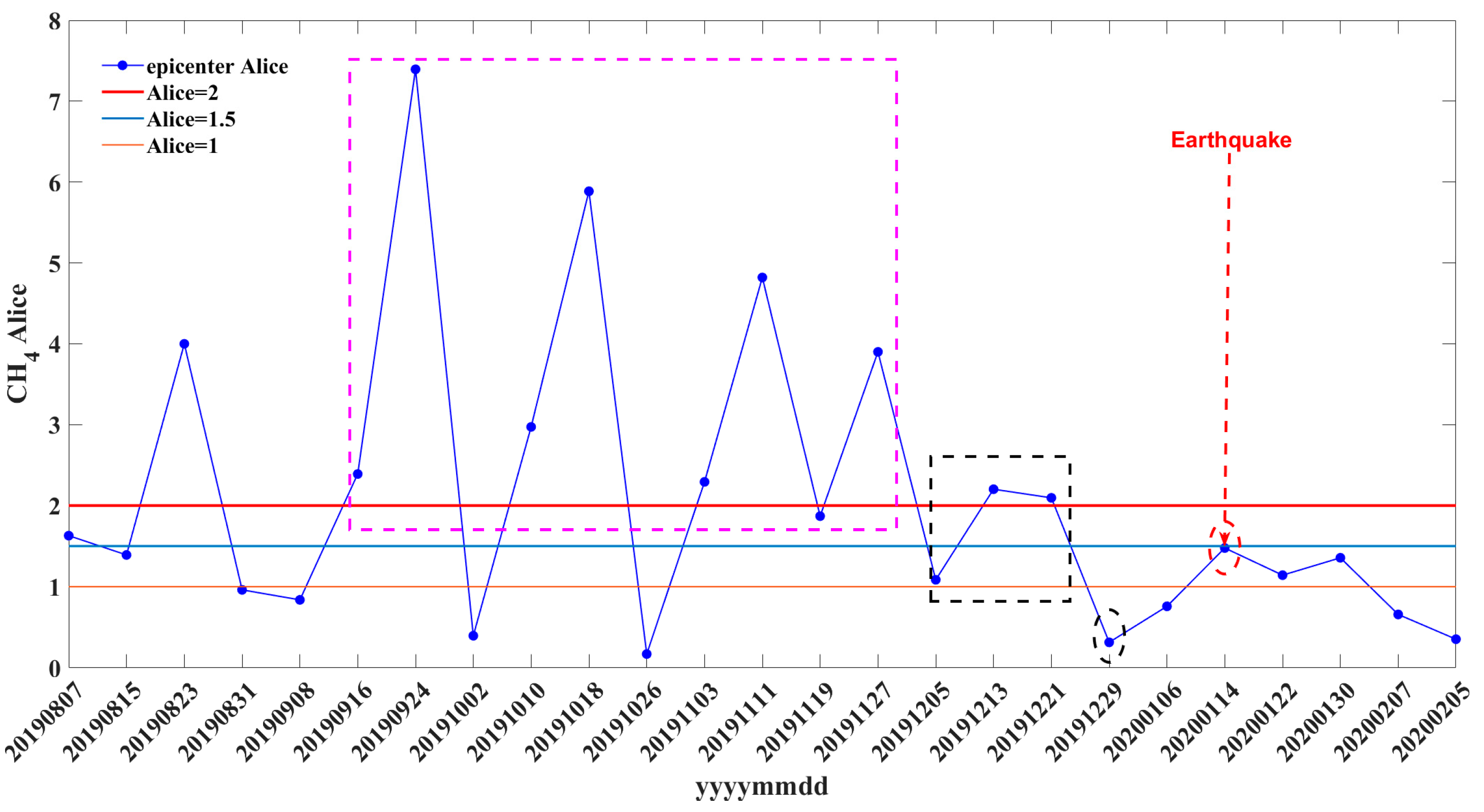
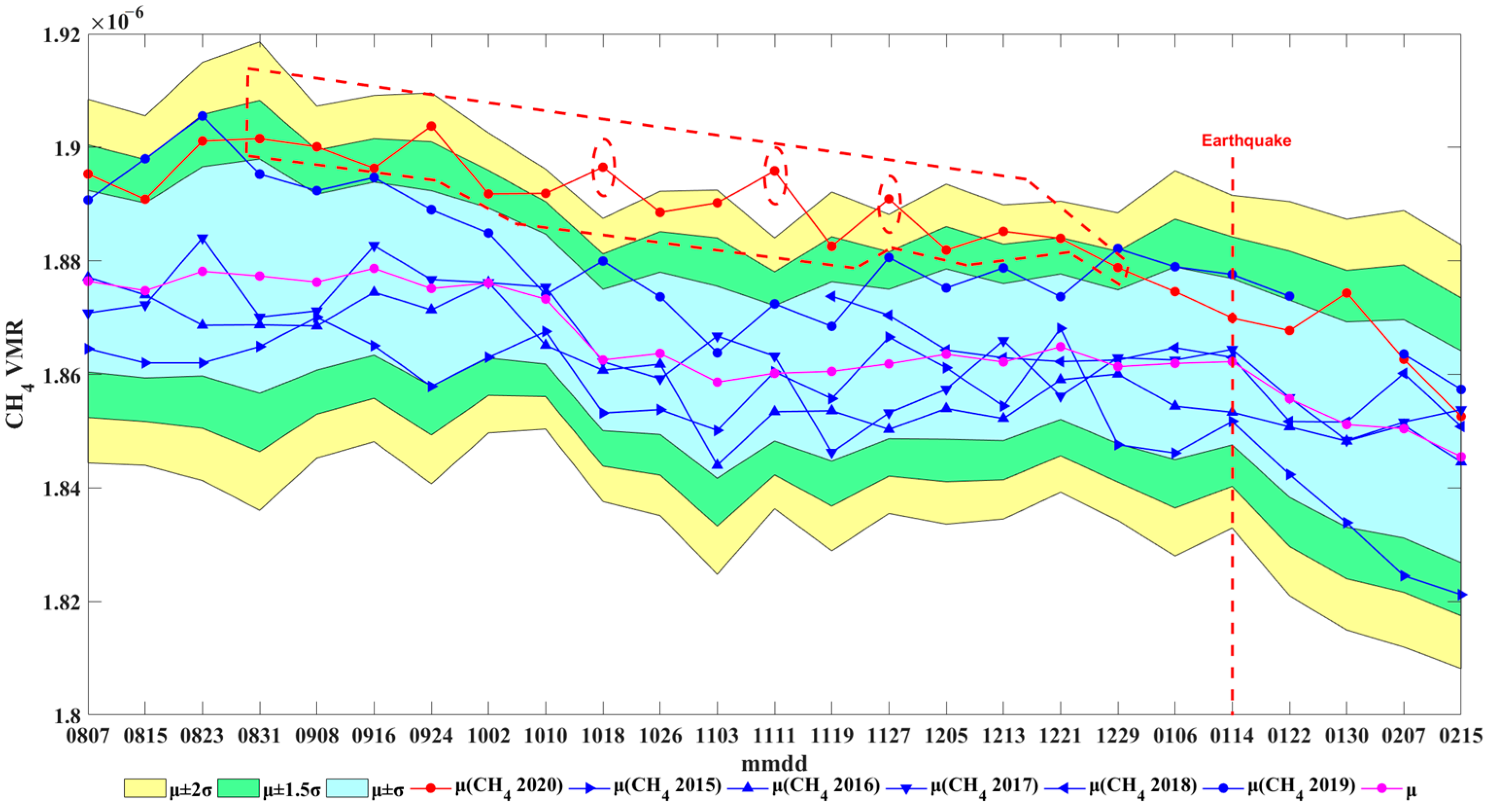

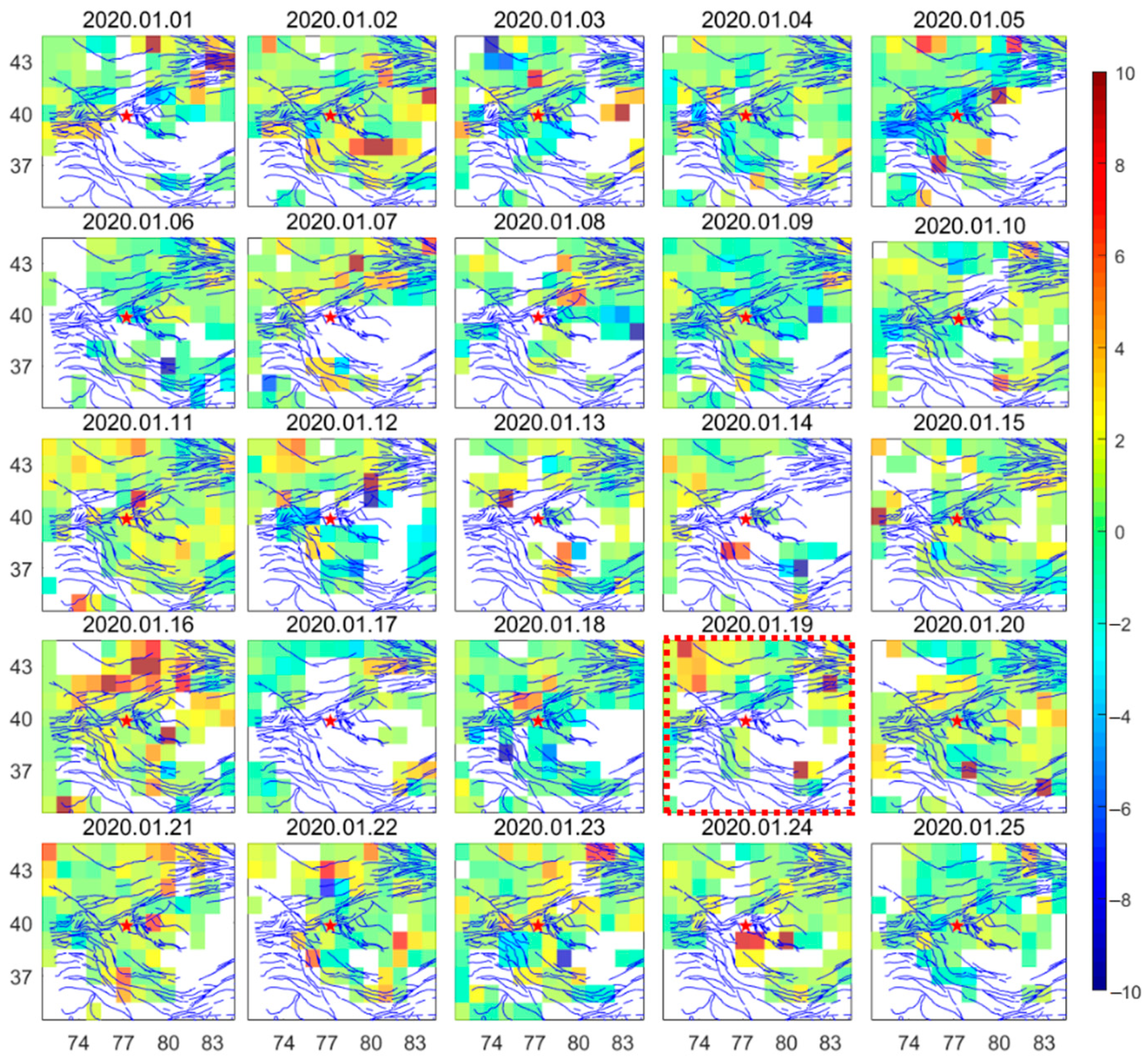
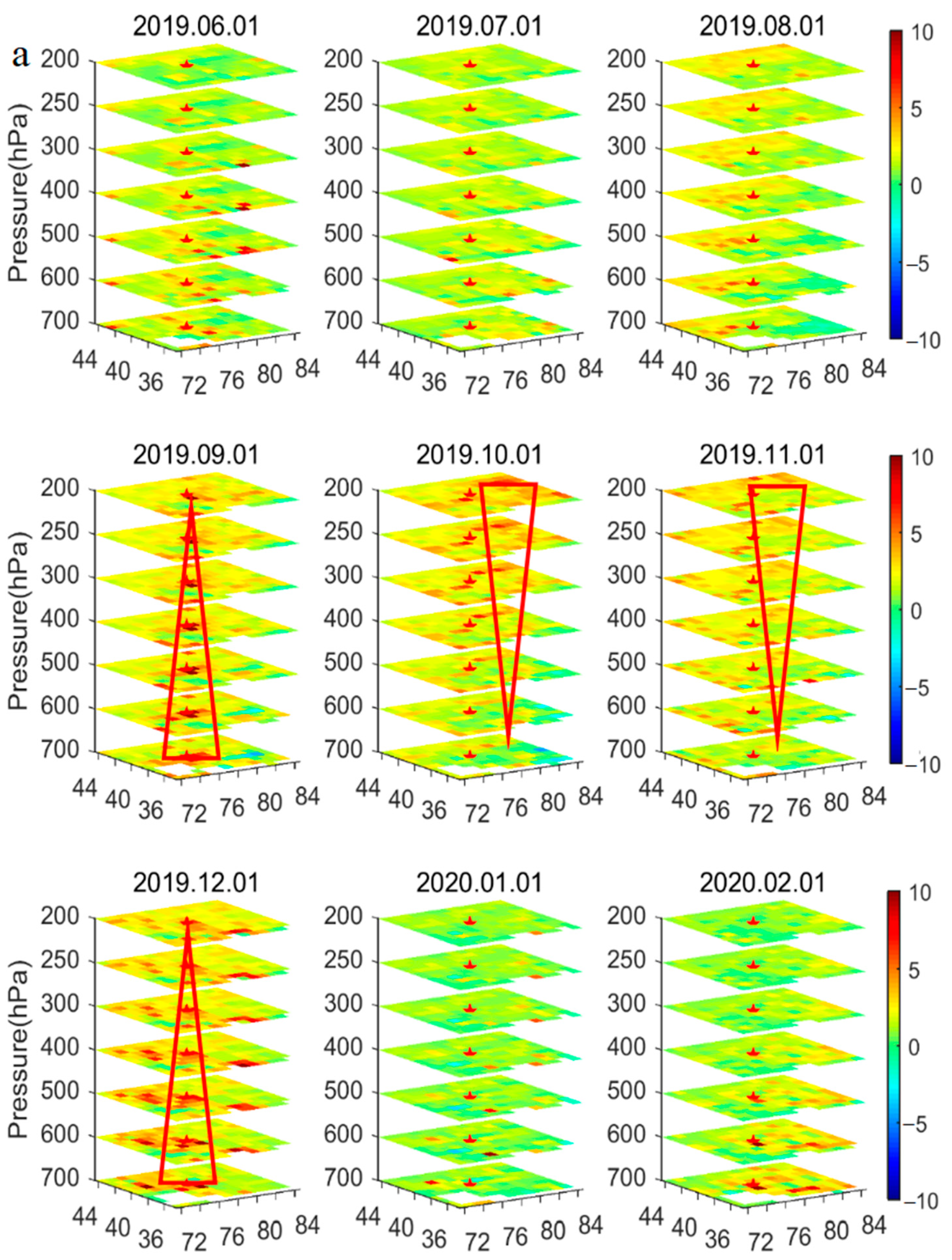
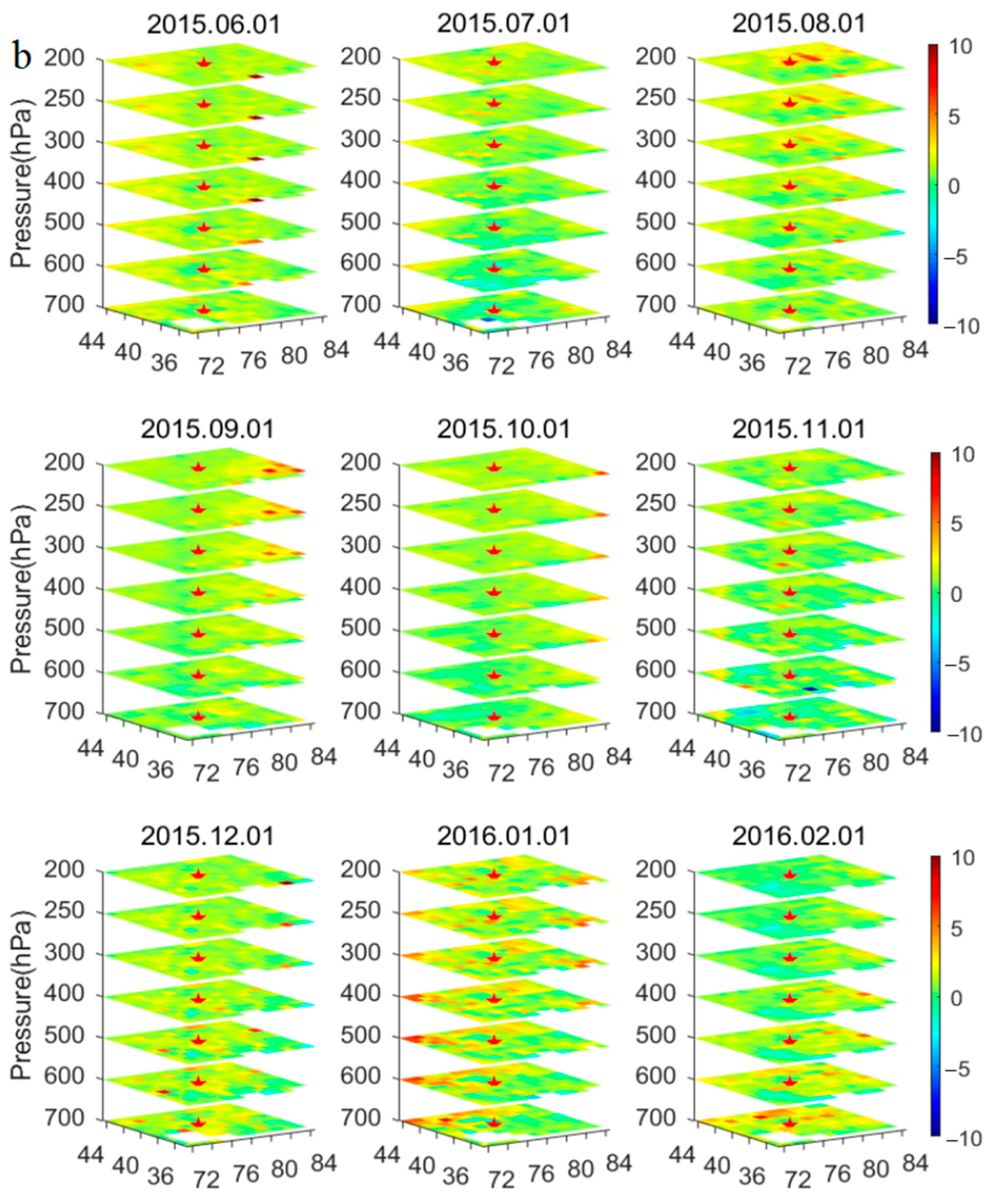
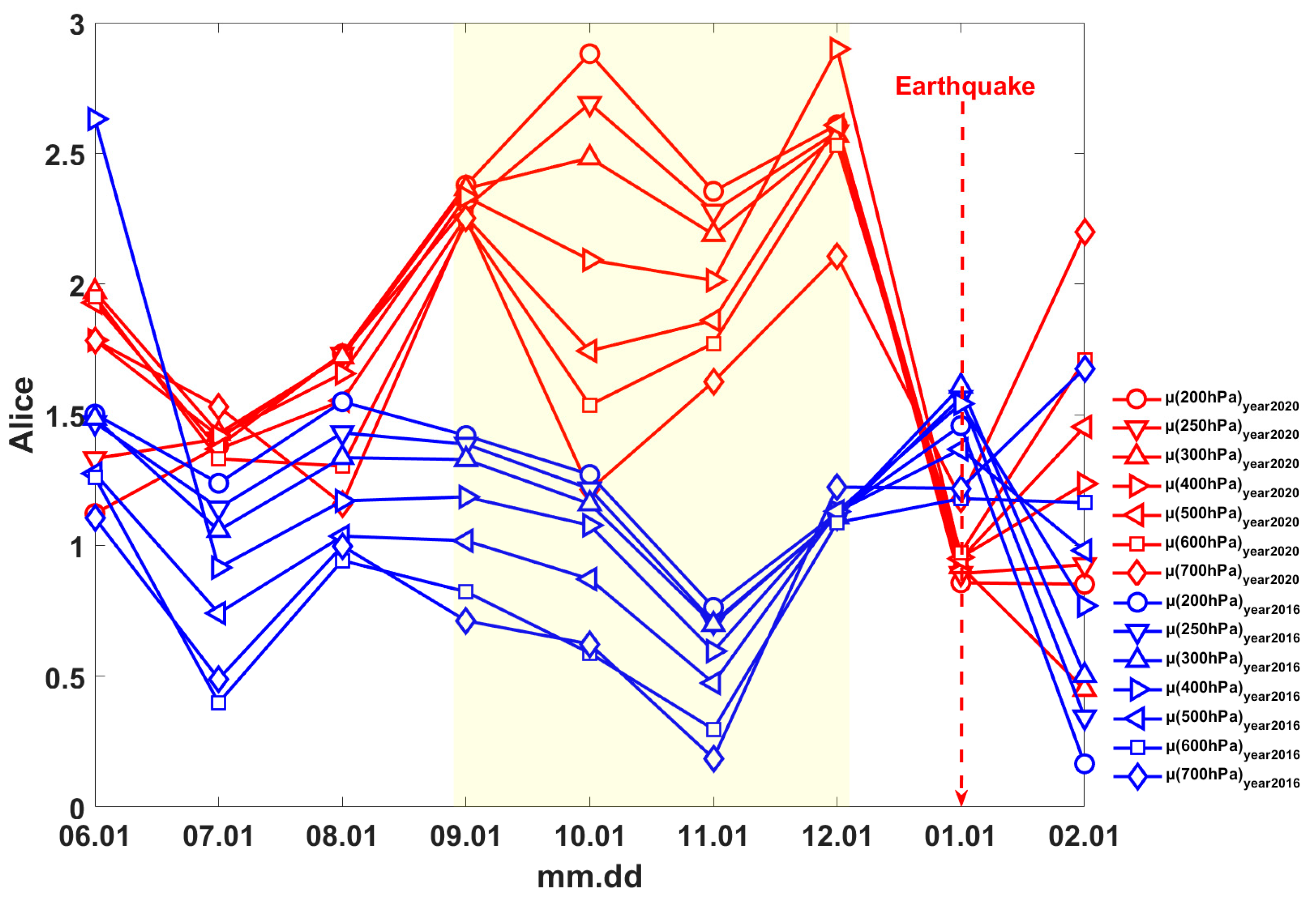
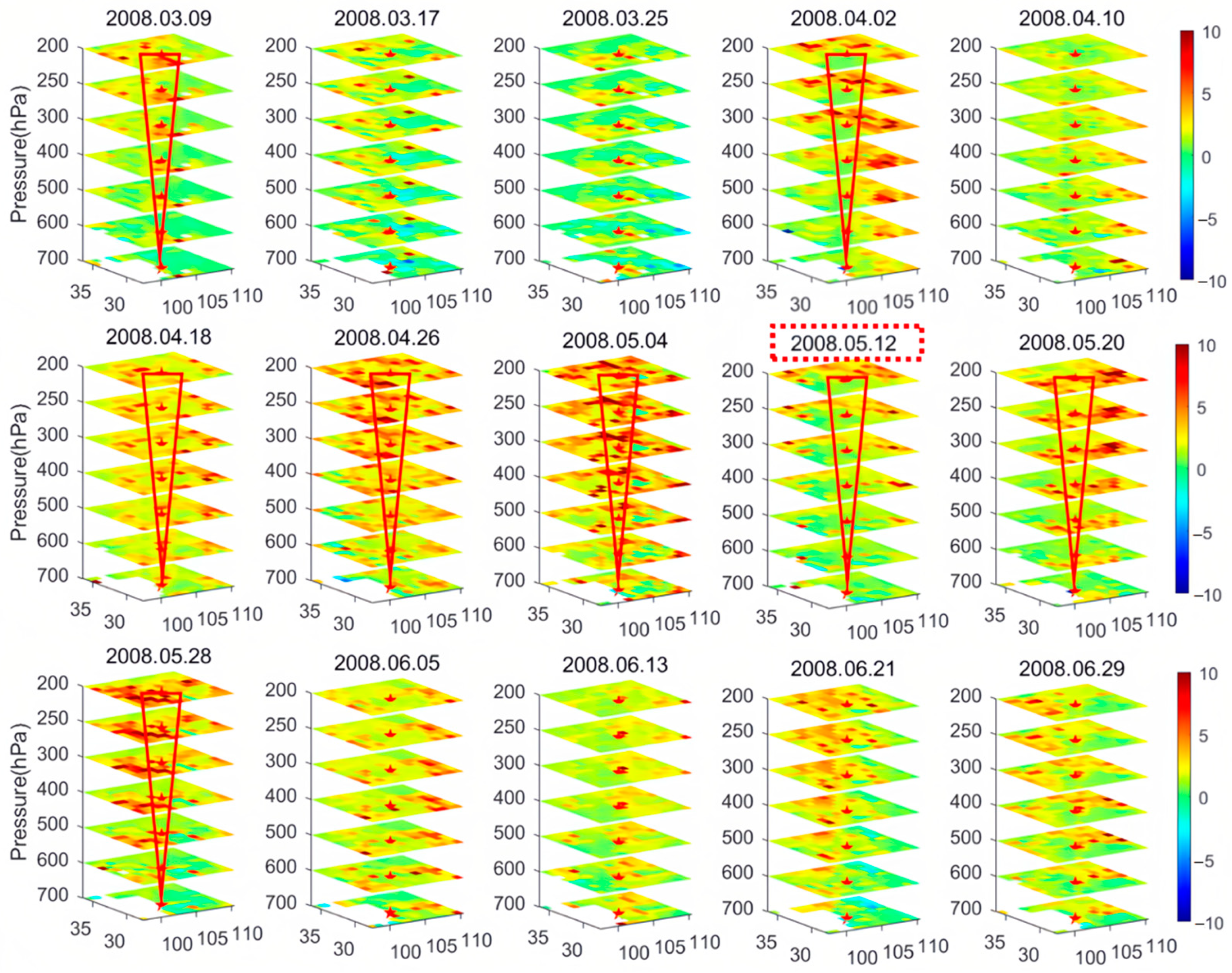
| Date of Earthquake | Epicenter | Magnitude | Longitude (°E) | Latitude (°N) | Depth (km) |
|---|---|---|---|---|---|
| 2015 November 18 | Kyrgyzstan | 6.0 | 73.04 | 40.38 | 7 |
| 2015 December 7 | Tajikistan | 7.4 | 72.90 | 38.20 | 30 |
| 2015 December 7 | Kyrgyzstan | 5.2 | 74.87 | 41.47 | 15 |
| 2015 December 7 | Tajikistan | 5.4 | 73.44 | 38.81 | 7 |
| 2016 January 14 | Luntai County, Bayin’guoleng Prefecture, Xinjiang | 5.3 | 84.12 | 42.19 | 5 |
Disclaimer/Publisher’s Note: The statements, opinions and data contained in all publications are solely those of the individual author(s) and contributor(s) and not of MDPI and/or the editor(s). MDPI and/or the editor(s) disclaim responsibility for any injury to people or property resulting from any ideas, methods, instructions or products referred to in the content. |
© 2024 by the authors. Licensee MDPI, Basel, Switzerland. This article is an open access article distributed under the terms and conditions of the Creative Commons Attribution (CC BY) license (https://creativecommons.org/licenses/by/4.0/).
Share and Cite
Wang, X.; Cui, J.; Zhima, Z.; Jiang, W.; Huang, Y.; Chen, H.; Li, Q.; Wang, L. Analysis of Seismic Methane Anomalies at the Multi-Spatial and Temporal Scales. Remote Sens. 2024, 16, 2175. https://doi.org/10.3390/rs16122175
Wang X, Cui J, Zhima Z, Jiang W, Huang Y, Chen H, Li Q, Wang L. Analysis of Seismic Methane Anomalies at the Multi-Spatial and Temporal Scales. Remote Sensing. 2024; 16(12):2175. https://doi.org/10.3390/rs16122175
Chicago/Turabian StyleWang, Xu, Jing Cui, Zeren Zhima, Wenliang Jiang, Yalan Huang, Hui Chen, Qiang Li, and Lin Wang. 2024. "Analysis of Seismic Methane Anomalies at the Multi-Spatial and Temporal Scales" Remote Sensing 16, no. 12: 2175. https://doi.org/10.3390/rs16122175




